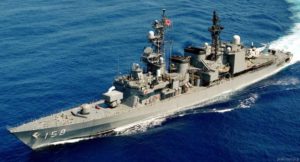by WorldTribune Staff, April 14, 2017
The United States, Japan and South Korea conducted their first joint anti-submarine warfare (ASW) exercises this week.
The three-day drill, which started on April 10, was held in waters between Japan and South Korea and was intended to be an “effective response” by the three allies to North Korea’s submarine activities, particularly Pyongyang’s sub-based ballistic missile capabilities, the South’s Defense Ministry said.

Japan’s Maritime Self-Defense Force said in a statement the drill was held to “bolster tactical cooperation” involving its helicopter-carrying Sawagiri destroyer.
South Korea sent its own destroyer and helicopters while the U.S. dispatched an Aegis-equipped destroyer and a P-3C Orion patrol plane.
Naval vessels will “search, detect and track a mock submarine, and exchange relevant information,” the South Korean Defense Ministry said following the drill.
“The anti-submarine training of the three countries is the first since it was discussed in their Defense Trilateral Talks in December,” the Yonhap news agency reported the ministry as saying.
The exercises began the same day Tokyo announced that Japan’s ambassador to South Korea would return to Seoul, ending a months-long dispute over a statue symbolizing the so-called comfort women, who were forced to provide sex in Japanese military brothels before and during World War II.
Tokyo and Seoul are also involved in a bitter territorial dispute over the Takeshima islets, known in South Korea as Dokdo.
In November, Japan and South Korea signed an agreement to share military intelligence on North Korea amid Pyongyang’s ramped-up nuclear and missile programs.
Analysts say the growing nuclear threat from the Kim Jong-Un regime has brought Japan and South Korea closer together, though some have warned not to anticipate closer ties in the near future.
The relationship between South Korea and Japan is such “that it seldom goes forward in a linear, strategically set-out fashion but in reactive response to regional events,” said Corey Wallace, a security analyst at Freie University in Berlin.
“I suspect that is the best we can expect for now,” Wallace said, adding that the U.S. deployment of the Terminal High Altitude Area Defense (THAAD) missile-defense system to South Korea to defend against the North’s missile threat — and China’s opposition to this — played a key role in driving Seoul closer to Tokyo.
“It was important for South Korea to demonstrate its independence,” Wallace said. “The perceived coercion by China actually played very poorly in Korea this time around, and may have provided a window of softened sentiment regarding cooperation with Japan for the ASW drills.”

